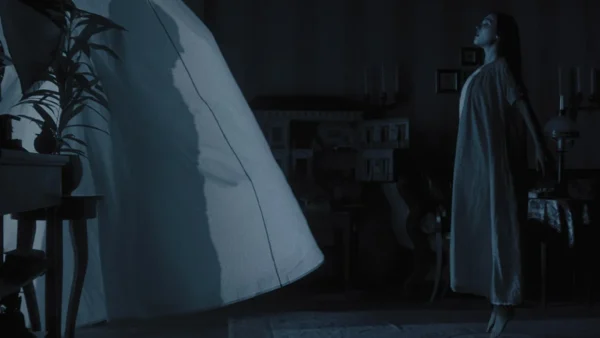“Nosferatu” opens up coffin for gothic horror
The haunting silhouette of Count Orlok is an image burned into the mind of viewers since 1922’s “Nosferatu,” directed by F.W. Murnau, debuted on screens. Bat like ears, two protruding fangs, a looming skeletal frame that strikes fear into any eyes that see it. Established director and horror auteur Robert Eggers has always been enamored with this chilling story, an offbeat adaptation of Bram Stoker’s seminal novel “Dracula,” and he finally got his hands on it. Unsurprisingly, Eggers released another horror masterpiece that will define an era in one of the best works in his filmography.
2024’s “Nosferatu” begins with a few seconds of harsh black. An empty void that is momentarily inhabited by the face of our lead actress, Lily-Rose Depp, playing a chilling but career defining role as Ellen Hutter. Ellen prays for guidance from somewhere beyond, a guardian angel or anything that can help her. Something responds. It’s not what she was expecting. This is how the terrifying but alluring dynamic of Ellen and our vampyric Count Orlok begins, and a prelude to the nightmare that is to come in the following two hours of the film’s constantly entertaining runtime. This delightfully dark vampire story has fans everywhere raving about its phenomenal execution, and faithfulness to the story of the eastern european vampires that are discussed and explored in the film. Eggers, in all of his works, amazingy researches the topic he’s dissecting and approaches it with the utmost care in preserving historical accuracy and delivering the best film he can.

Eggers and longtime director of photography Jarin Blaschke, who has done the beautiful camera work for all of Eggers’ feature films, come together once again for a technically beautiful and cinematically gorgeous film. “Nosferatu” is mostly dark, with the events of most of the film taking place at night, but the film doesn’t fall under the trap of what other “dark” films fall under. Even on the darkest night, you can clearly see everything you are supposed to. The blue light of the moon illuminates everything on frame that needs to be seen, and gives the film an almost black and white color palette that gives an amazing atmosphere and makes a single shot look like a painting. Specifically, there is a shot of a wagon traveling through the Carpathian Mountains to the looming castle of Count Orlok, illuminated by moonlight and brimming with a gothic atmosphere.
All of the special effects in “Nosferatu” were done physically, including the thousand of rats in the film and all the prosthetics that help Bill Skarsgard deliver his terrifying performance as Count Orlok. Many fans agree that the usage of physical effects lends itself to the aura and lasting power of the film, and it brings it into reality in a way that most films utilizing computer graphics lack. It even nabbed an Oscar nominee for best makeup and costuming, among others, which are monumental for the horror genre.
“Nosferatu” marks the beginning of a return to one of horror’s most classic genres: gothic horror. Gothic horror is primarily rooted in literature, and its adaptations to film have been some of the most popular horror films in history. The subgenre originated in 1764 with the publication of “The Castle of Otranto” written by Horace Walpole. Markers of the genre are palpable atmospheres of mystery and looming danger, supernatural events, intense emotions, omens and visions, curses, prophecies, and sometimes most importantly: dark romances. Notable contributors to this genre of literature include Shirley Jackson, Edgar Allen Poe, and Henry James, whose novel “The Turning of the Screw” was adapted into 1961’s “The Innocents,” which Eggers specifically cited as a huge inspiration for the cinematography and atmosphere of “Nosferatu.” Gothic horror has long been a favorite of the fans, and the box office and cultural success of “Nosferatu” will very likely mean its coming back in style for 2025. Two new “Frankenstein” adaptations are already on the way!
On a budget of $50 million, “Nosferatu” racked up $112 million, three Oscar nominations, and a place in pop culture history as one of the best horror remakes and possibly one of the best horror films of all time. The horror community loves to see horror movies win in these ways, receiving the recognition they deserve as pieces of cinema and history, not just entertainment. Eggers has two new films in the works, the 13th century set “Werwulf” and a sequel to Jim Henson’s classic film “Labyrinth.” Horror came through in full force for 2024, and here’s to hoping this recent trend of great filmmaking in every aspect will continue throughout the new year. “Nosferatu” sticks with viewers long after watching, leading to the popular responses on the internet that is leaving the film in the public eye a month after its release. It leaves a specific taste in your mouth, one that anyone would be hard pressed to forget… blood.


I watched this movie in theaters when it came out, and it was pretty scary to me, but I also thought it was very strange how they made the relationship between Count Orlock and Ellen weird and kind of freaky. Nevertheless, I thought the actors performed very well, and the plot was good.
Bro gothic horror is one of the best of its generation
girl you ate